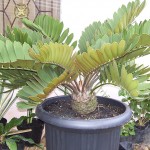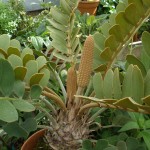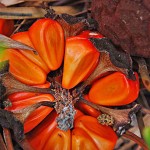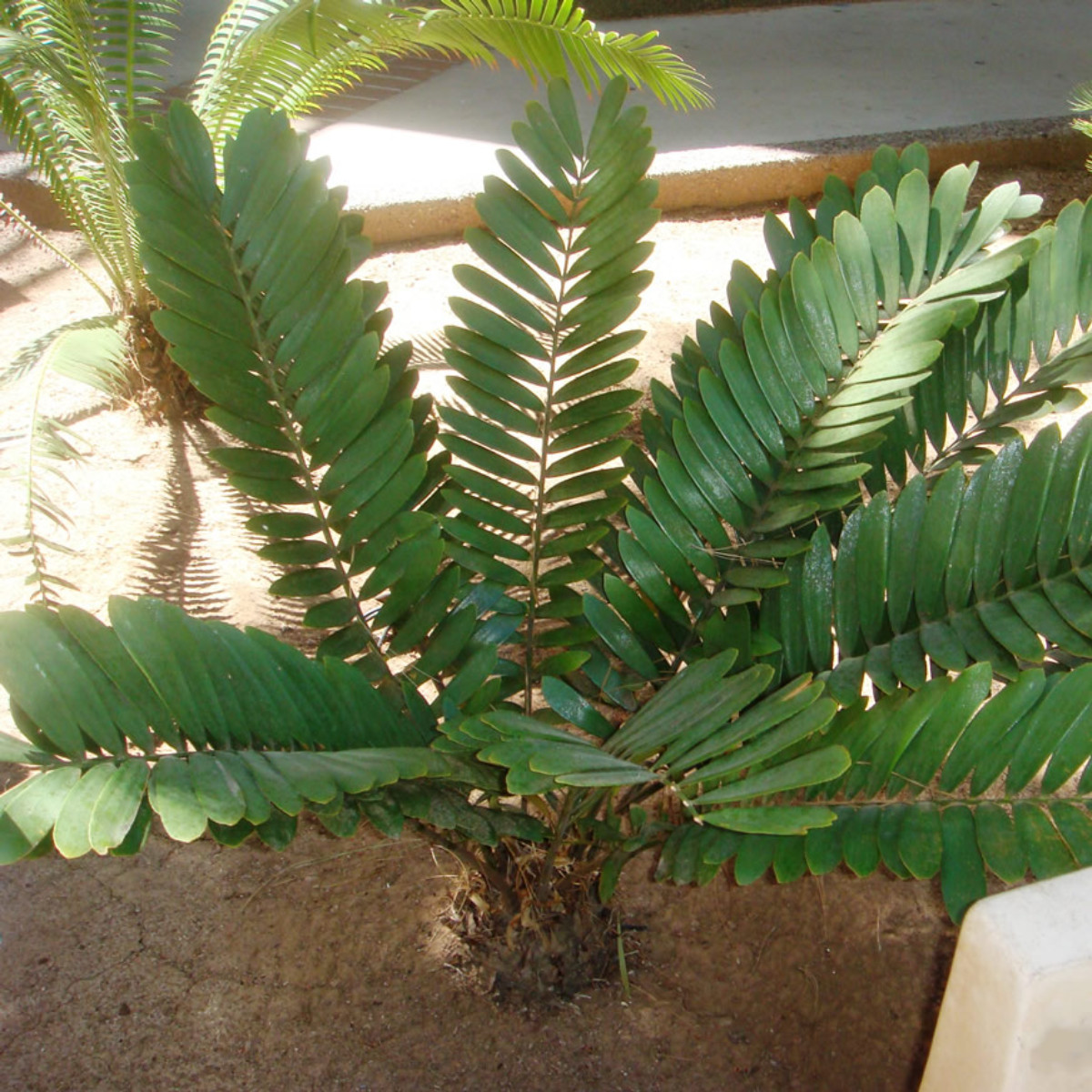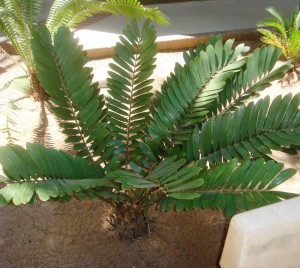Family: Zamiaceae
Synonymous: Palmifolium furfuraceum
Palma pumila
Zamia crassifolia
Zamia gutierrezii
Zamia vestita
Zamia fusca
Zamia maritima
Distribution and habitat: Zamia furfuracea is a cycad native to Mexico in a small mountain range in central Veracruz. This species grows in areas varying from generally arid thorn scrub to sandy soils and in limestone sea cliffs.
Description: Zamia furfuracea has long folds which arch from a central crown. The fronds carry tightly packed leaflets which give the plant a fern-like appearance. The thick leathery leaves are pinnate and have 13 cm (5 inch) long by 3cm (1 inch) wide oval leaflets. They are slightly fuzzy and feel a little like cardboard when rubbed. Occasionally, the leaflets are toothed toward the tips. The circular crowns of leaves resemble fern or palm fronds.
The plant has a short, sometimes subterranean trunk up to 20cm (8 inch) broad and high, usually with no ramification and marked with scars from old leaf bases. It grows very slowly when young, but its growth accelerates after the trunk matures. This fleshy trunk serves as a water reservoir in times of drought. When the plant is young, the fronds appear to rise directly from the ground.
This plant produces a rusty-brown cone in the center of the female plant. The egg-shaped female (seed-producing) cones and smaller male (pollen-producing) cone clusters are produced on separate plants. Even very young plants produce these interestingly shaped cones.
When ripe, the female cone breaks to reveal an array of tightly packed, bright red 3cm (1 inch) seeds.
Houseplant: In temperate regions it is commonly grown as a houseplant and, in subtropical areas, as a container or bedding plant outdoors. It is qualified as an easy to grow plant, but has a slow growth rate.
Specimens can be grown indoors in shallow containers. In this way, the partially exposed trunk (tuberous stem) and the airy crown of leaves create a striking bonsai specimen.
Light: Zamia furfuracea grows in bright light to full sun. Turn the plant regularly in front of the window so that it will grow evenly. Otherwise, the stems will grow toward the sunlight, creating a lop-sided plant.
Temperature: Normal room temperatures are suitable for this cycad year-round ranging between 16-24C (60-75F).
This plant thrives in average to low humidity condition.
Water: Water only when the potting mixture is completely dry, pour water till it flows out of the bottom of the pot. It is drought resistant, being a semi-succulent that stores water in its trunk. Do not allow the potting mixture to get too dry, though, or this plant may drop its leaves.
Avoid getting water on the base of the plant or the foliage because can cause Zamia furfuracea to rot. Water the potting mix only.
Fertiliser: Feed once in spring and again in summer with a slow-release fertiliser.
Potting and repotting: Repotting Zamia furfuracea should not be necessary more often than about once in every two or three years as the plant does not like to be disturbed.Use a heavy container to prevent toppling, because these plants can get top-heavy. Move the plants into one size larger pot in spring when the plant becomes root-bound; use an equal parts good-quality potting mix and sand for good drainage.
After reaching maximum pot size, top-dress these plants by replacing the top 5-8cm (2-3 inch) of potting mixture with fresh one.
Gardening: This plant is easy to care for. They are fairly salt- and drought-tolerant, but should be protected from extreme cold.
Position: Zamia furfuraceado well in full sun or shade, but not in constant deep shade. The crown of this plant will grow erect in full sun and horizontal in shade.
Soil: It tolerates a variety of well-drained soils.
Irrigation: Watering should be done with moderation because plants are drought-tolerant once they become established.
Fertilising: Needs fertilizer only once a year in spring: mulch with organic material (bark and leaf) or provide palm fertilizer.
Propagation: Zamia furfuracea plant can be reproduced by seed. The fleshy, brightly crimson-colored seeds are produced by the female plants. The germination process is very slow and difficult to achieve in cultivation. Seedlings are slow-growing and will take years for them to grow tall. Zamia furfuracea propagation is not really feasible for the home gardener. Zamia furfuracea is popular cycad usually available in nurseries or florist shops.
Not all seeds collected from a mature plant are fertile unless they are cross-pollinated.
Notes: Zamia furfuracea is a "living fossil" plants, its kind surviving on earth since the time of the dinosaurs.
Because seed germination is a very slow and difficult, many plants sold for horticultural use are illegally collected in the wild, leading to the species being classified as vulnerable in its natural habitat.
Uses: Zamia furfuracea is a great houseplant tough enough to survive occasional neglect and harsh indoor environments.It makes a great dramatic accent or specimen plant. Also it makes a great container plant for the patio or deck.
It is use for border, mass planting, container or above-ground planter, in mixed foundation plantings or in perennial beds.
This cycad is salt resistant and can be used in beachside plantings.
Toxicity: All parts of the plant including seeds are poisonous to animals and humans. The toxicity causes liver and kidney failure, as well as eventual paralysis. Dehydration sets in very quickly. No treatment for the poisoning is currently known. Protect pets and children to never eat or chew any part of this plant.
SUMMARY:
CHARACTERISTICS:
Foliage green
Shape rosette
Height: 0.6-1.5m (2-5 feet)
Spread: 1.5-2.5m (5-8 feet)
PROPER CARE:
Watering in rest period sparingly
Watering in active growth period moderately
Light bright filtered
Temperature in rest period min 13C max 24C (55-75F)
Temperature in active growth period min 16C max 24C (60-75F)
Humidity low
Hardiness zones: 9b - 11
